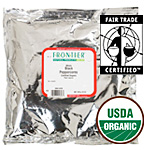Using Cacao, Part 1:
Is Cocoa Powder and Cacao Powder the Same Thing?
Ardent students of chocolate that we are, this is not the first time we’ve discussed cocoa. You can read Wilson’s articles on Pantry Paratus called: The History of Chocolate (Part 1), Chocolate Part 2(The art & science of how it is made), and then Chocolate in America (his 3rd part of the series). But let’s move on to more practical matters: Is cocoa powder and cacao powder the same thing? And should I get raw, organic, or fair trade–or the candy bar of my childhood?
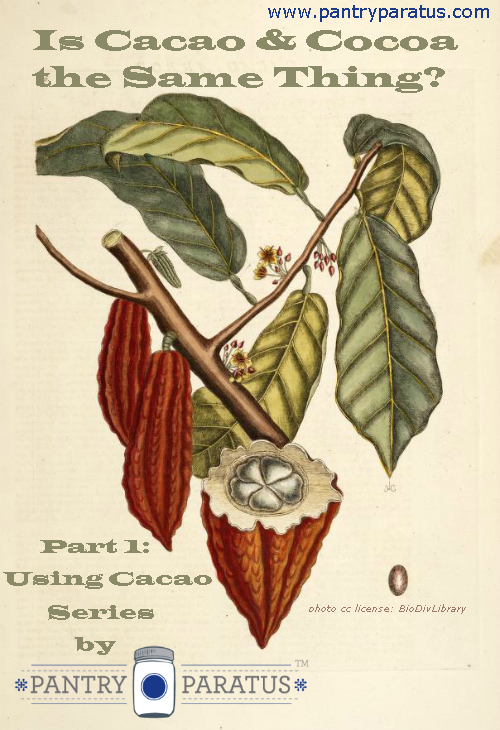
Cocoa vs. Cacao
At this point, the words are used interchangeably. Cacao sounds fancier, don’t you think? Apparently, the producers do too, since you see that spelling more frequently than ever before. You will see the term “cacao” in reference to more plant-based products, such as the bean (Theobroma Cacao in Latin). The FDA regulations allow for the words to be used interchangeably. We’re going to go through every chocolate term more extensively in part 2 of this series.
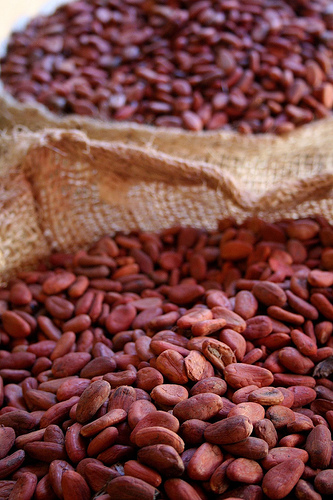
What is “Raw” Cacao?
I would first caution you to avoid anything deemed “raw” when it comes to cacao, simply because the benefit/cost analysis will not be in your favor. The theory of it is wonderful and all, but the technology has not caught up, making it unbearably expensive and questionable as to the real “raw” status. At this time, there is not an FDA guideline for the use of the word “raw” (sort of like the word “natural”).
Wilson goes into more detail in the above articles about cacao processing; but cacao is a slimy, fermented bean and it must be so. The fermentation process turns the white bean into a brownish-red one and significantly alters the flavor. The piles of raw, fermenting cocao beans reach extremely high temperatures; even those striving to keep temperatures down say that the beans must reach at least 80 degrees for full flavor. The generally accepted standard for the term usage of “raw” is anything not raised above 115° F. Due to the outdoor and tropical nature of cacao processing, the known temperature of each fermenting pile is not usually known nor tracked.
The beans are then dried in the hot tropical sun and/or roasted; and so one might suppose that a “raw” cacao bean means that it simply was not roasted. In either case, it was fermented out in the hot sun under which the temperatures are not within the “raw” standards. “Raw” also generally means it was cold-pressed (in contrast to heat-pressed).
I found many articles about this, but you can read more about the impossibility of meeting the true “raw” standards by a farm attempting it. Overall, the “raw” version may or may not be truly raw but it has undergone minimal processing; thereby probably is better for you. The extremely labor-intensive process required to keep it raw makes purchasing it cost-prohibitive for most. There are many steps to the process, but according to the article above, the required method of hand-peeling alone makes it cost-prohibitive; they said that 1 laborer can only peel 4 pounds a day. Notwithstanding the actual farming, transportation, and other processing costs—either that poor worker is making very little (as is common in cacao processing), or you are selling your kidney. If you are not selling your kidney and it’s labeled “raw” question that.
Organic and Fair Trade Cacao
If you want to have a nice visual of what goes into conventional cocao processing (not the raw stuff), take a look at this. We once discussed the ethics of using palm oil (which is in many brands’ finished chocolate products), and this is an area where we should likely place ethics into the cost/benefit analysis. Over 200,000 children, quite a few of whom have been trafficked and might be as young as five years old, do the difficult work. Between 50-65% of the crop is given directly to the plantation owners from the farmers who contract the land (see either of the last two documents hyperlinked above). All chocolate needs to be considered judiciously for such ethical reasons, raw cacao even more so, since the processing costs are astronomical. You will need to do the research company-by-company for yourself; I hesitate to say too much here since these things can change over time (or at least, we hope so) but I will give you a quick heads-up: Nestle has the most notorious reputation, but others are bad, too.
I want my chocolate. But I want it ethically.
This is why we buy fair trade and organic cacao nibs and cocoa mix, produced and packaged for Frontier. Frontier has an outstanding reputation for ethics, ecology, and quality. We are asked to sell products from other companies, but we have a firm commitment to selling only what we can affirm was done to the highest standards and has a level of transparency to the end consumer.
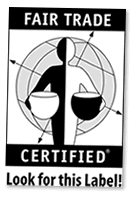
Fair Trade is the internationally-recognized gold standard for social responsibility. TransFair USA’s rigorous audit system, which tracks products from farm to finished product, verifies industry compliance with Fair Trade criteria. TransFair allows U.S. companies to display the Fair Trade Certified™ label on products that meet strict Fair Trade standards. When you purchase organic, fair trade products through Pantry Paratus, you are ensuring fair pay for farmers, charitable work in their communities through Frontier’s commitment to give back, and sound ecological practices for the land.
Three Ways To Support Ethical Chocolate
1) Look for certifications on your chocolate that indicates to you an ethical responsibility on the part of the chocolatier, such as organic, fair trade. Another highly trusted badge is Rain Forest Alliance Certification.
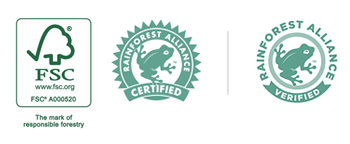
2) Support small businesses (cough, cough) that are more altruistic than business-saavy and prioritize ethics over the bottom line. You can ask questions and get straight answers; there is a higher level of accountability and small businesses love to hear your concerns and respond accordingly. If you ever want to talk to us about what we sell at Pantry Paratus and why, email us at [email protected]. You’ll get a personal response.
3) Shop ahead, buy in bulk. This cuts down on those nasty little impulse-buys. Organic, Fair Trade Chocolate also makes a wonderful gift. Having a few bags of cacao nibs in the cupboard is what I call true preparedness!
Stay tuned–we’ve got more about cacao coming up. Learn about the variations of chocolate (semi-sweet vs. sweet, etc). Find out how to use cacao nibs, how to make your own cocoa powder, and try some awesome recipes. This and more will be coming soon!
Because ethical food is also the most nourishing,
Chaya
Shop for baking supplies here.
Proviso:
Nothing in this blog constitutes medical or legal advice. You should consult your own physician before making any dietary changes. Statements in this blog may or may not be congruent with current USDA or FDA guidance.
Photo Credits
Cacao Beans in Burlap: A30_Tsitika via photopin cc
Color Drawing of Theobroma Cacao: cc license, found at: http://biodiversitylibrary.org/page/10900321#page/224/mode/1up



